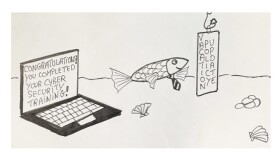Efforts are underway in Washington to revamp U.S. foreign aid in the wake of the coronavirus.
Proposals from both the White House and the Senate would shift billions of dollars in foreign assistance, consolidate control over U.S. humanitarian aid in the State Department and — according to one former top aid official — undermine the lifesaving work of USAID.
The U.S. is by far the largest donor to global health and development programs around the world. Leaders in Washington want to leverage the billions of dollars in aid various U.S. government agencies spend each year in low- and middle-income countries to make it more likely that the next emerging disease is discovered and contained before it poses a threat to Americans. The idea is that along with building up health systems in developing countries, the U.S. would push for disease surveillance networks in these places.
Andrew Natsios, who led USAID from 2001 to 2006 under George W. Bush, strongly objects to some of the ideas being floated in the latest initiatives.
Under a plan from the White House called the President's Response to Outbreaks or PRO, international global health programs now run by USAID would be shifted to a new unit in the State Department.
Details of the proposal were first reported by Devex in late May.
Natsios says American foreign assistance programs should be revamped, but he says moving public health programs run by USAID over to the State Department while asking USAID to continue to handle emergency food assistance doesn't make sense. During an online forum sponsored by the Center for Strategic and International Studies on June 2, Natsios said severing food aid from health programs will unintentionally lead to far more children dying from preventable diseases during humanitarian disasters and other crisis.
"Ninety percent of the people who die in famines die from communicable or infectious disease before they actually starve to death because starvation causes a collapse of your immune system," Natsios said in an interview with NPR from his home in Texas, where he's the director of the Scowcroft Institute of International Affairs at the Bush School of Government at Texas A&M University.
"In famine responses, we always combine mass public health programs with massive food and nutrition programs," he said. "If you separate the two, you're ultimately going to paralyze our responses."
In addition to the President's Response to Outbreaks, a bill introduced in the Senate called the "Global Health Security and Diplomacy Act of 2020" would also restructure some foreign assistance programs in an effort to better prepare the U.S. for another pandemic. It would authorize $3 billion for pandemic preparedness, including strengthening health systems in low-income countries to better detect new emerging diseases. It would shift control of some overseas aid programs run by USAID as well as the National Institutes of Health, the Centers for Disease Control and Prevention and the U.S. Department of Agriculture and put them under a new coordinator in the State Department.
This bill is controversial in part because USAID is an independent federal agency whose administrator serves at the will of the president. It was created in 1961 by President John F. Kennedy to be the U.S. government's lead agency in providing humanitarian and development assistance around the world. At the time Kennedy said the goal was to "help the new and developing states of the world grow in political independence, economic welfare and social justice."
USAID was modeled after the Marshall Plan, which helped rebuild Europe after World War II. The goal was to reduce poverty but also to win international hearts and minds — and also consumers for U.S. goods — in the midst of the Cold War.
The separation of USAID from the overtly political State Department was deliberate.
"There's been a gradual attempt over a number of administrations by both parties to absorb A-I-D into State," says Natsios. "A wholesale attempt was made in the 1990s to do that. There was a huge outcry by the NGOs, by the church community and by advocacy groups against it. And it was defeated."
The U.S. spends billions of dollars on aid and development assistance around the world every year through various departments including the State Department. But USAID is the most prominent. During natural disasters and in refugee camps, bags of grain emblazoned with the USAID logo and the phrase "From the American People" are ubiquitous.
Governments spend money on international assistance to advance their own agendas. In addition to offering assistance around the world, USAID has a mission statement that, in part, says its role is to "support America's foreign policy." Despite this, Natsios says it would problematic to have the U.S.'s primary humanitarian aid agency being run by the diplomats at the State Department.
"The mission of aid has always been to protect the national interests of the United States, broadly defined. And that point is very important, broadly defined," he says.
"A stable, peaceful international order that respects democracy and human rights is the interests of the United States. It's also in the interests of countries in the developing world."
Under the Trump administration, there's been an effort to use aid in a more transactional manner. That new stance is reflected in a change in the mission statement on USAID's Twitter page. Prior to 2018 it read: "USAID works to end extreme global poverty and enable resilient, democratic societies to realize their potential." That year it was changed to: "We advance U.S. natl. security & economic prosperity, demonstrate American generosity & promote self-reliance & resilience."
This current logo is more in line with the work of the State Department, which has a goal of promoting U.S. interests globally rather than reducing global poverty. Natsios says the work of the State Department is often driven by short-term priorities rather than the long-term goal of lifting another nation out of poverty, as the U.S. did in South Korea in the 1960s and 70s.
"At State they're not trained in development. They're trained in diplomacy, and they're not the same thing," he says.
Natsios, who describes himself as a "Massachusetts Republican," says the current separation of USAID from the State Department insulates development programs from the political whims of the White House.
He says President Trump in particular tries to use assistance to punish foreign leaders who cross him.
"Most of what he's done with foreign aid until now is to deny it to people who don't do what he wants. And we've done that before. All presidents do that. But he has done it more than anybody since the end of the Second World War," Natsios says of Trump. "No one has used foreign aid as a stick more than he has. It's usually much more effective if you use foreign assistance as an incentive. It doesn't work so well when you threaten."
James Richardson who heads the State Department's Office of U.S. Foreign Assistance Resources, joined Natsios at the CSIS event on proposed restructuring of U.S. global pandemic response.
"The American people are the leading donor of global health around the world. We beat the next largest donor by five times," Richardson said. "We the American people have spent over $140 billion over the past 20 years building out global health systems around the world. And that's something should we really be proud of."
The Office of U.S. Foreign Assistance Resources was set up inside the State Department in 2006 to coordinate U.S. government international aid programs. Richardson declined to comment on the specific reform proposals being offered up in Congress and at the White House, but he said the current COVID pandemic shows that current disease response systems aren't working.
"Let's just be completely honest. The international system of the WHO and others have failed us when it comes to outbreaks," Richardson said.
He said the U.S. needs to build a new global health security system and much of that could piggy-back on existing U.S. foreign aid programs.
"We need to have a coordinated U.S. government response from State, USAID, CDC, DOJ, the USDA," Richardson said. "All of them need to be working together in a coordinated fashion in order to achieve greater impact and results. And we can't wait for a pandemic to hit for us to become organized in that way."
The White House's PRO plan would consolidate programs from many of the agencies Richardson mentions, including USAID, and put them under a single coordinator at the State Department. The idea is to make single federal entity that could pull on a vast array of government resources to respond to the next pandemic.
But some in the development world worry that centralizing foreign aid programs primarily to prevent outbreaks from spreading abroad might not be what recipients in low-income countries actually need.
"The challenge here is that the interests of the United States may not be in sync and often aren't in sync with what the developing country that is receiving the aid actually needs," says Niranjali Amerasinghe, head of ActionAid USA, a nonprofit that works on global poverty and inequality.
Amerasinghe says aid is most effective when it's driven by needs of the recipient communities not the donors.
"A good example of this is the Trump administration has been very clear that it does not consider climate change to be a priority either nationally or globally. But in many developing countries, climate change is one of the biggest challenges that communities are facing. Climate impacts are affecting agriculture for local farmers who are trying to grow food and can't because of either increased rainfall intensity or drought," she says. "And if you are not aligning with what the community needs in terms of addressing climate impacts, because the United States government does not want to prioritize climate change, then you're not going to make a meaningful impact in people's lives."
So even if the goal is build stronger health systems around the world in part to make sure that emerging infectious diseases are detected more quickly, Natsios and others say that's going to be more difficult if there isn't local support for the programs.
Amerasinghe agrees that there should be reforms to U.S. foreign assistance, but she says the reforms should give recipients more say in what projects gets funded.
"The bottom line," Amerasinghe says, "you're not going to solve global poverty by advancing U.S. national interests as your primary goal in aid budgets."
Copyright 2020 NPR. To see more, visit https://www.npr.org.






